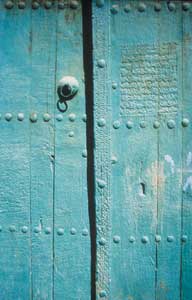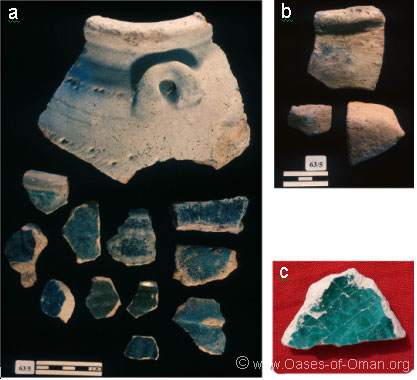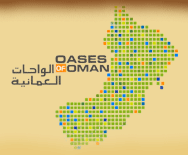Objectives: Documentation of elements of traditional material culture, including architecture, architectural decoration and ceramics. Gathering of oral traditions and written documents from the oases, as well as reports and maps by non-Omani authors. Conclusions on the development of oases in the historical period, from the early Islamic period to the 20th century, and identification of factors influencing the history and material culture of the oases.
Contact Person: Prof. Dr. Heinz Gaube, Orientalisches Seminar, University of Tübingen
Scientific staff: Prof. Dr. Heinz Gaube, Dr. Birgit Mershen, Dr. Lorenz Korn, Dr. Michaela Hoffmann-Ruf
Study area: Al-Hamra, Misfat al-‘Abriyin, Balad Seet; Tiwi, Maqta’, Ibra; Izki, Nizwa, Bahla.
Duration: 2001-2008
Oral history
The history of oases in Oman cannot be understood from written documents and material evidence alone. Research in the different oases revealed that a living practice of oral tradition exists. In some places, it covers more ‘recent’ events which can be compared with other evidence, while in other cases distant events are recorded in the form of folk tales.
Oral tradition has proved an indispensable source of information for events which happened during a span of approximately the last five generations. Inhabitants of the oases were partners of informal interviews during the repeated field campaigns. This way, information on recent changes (since the 1970s) as well as on the previous state of some oasis settlements was obtained, and the structure of ownership of certain buildings could be ascertained (cf. Korn et al., 2004). In some cases like Ibra/al-Manzafa, it was possible to compare information from oral tradition with that from written chronicles. In such cases, an influence of the literary tradition on oral transmission cannot be excluded.
In the field of folk tales, some material was recorded, but probably still more is being transmitted. The tales recorded at Tiwi revealed highly interesting features. The interrelationship of nature, man and built environment is an important issue. Allusions to the pre-history of Arab settlement in Oman, as recorded in chronicles, can be discovered. At the same time, magic plays a crucial role in the development of the plot (cf. Mershen 2004).
In general, it appears that oral history is a rich source which was not (and could not be) exploited to the full extend in the present research project. With respect to the large oases of the interior, more material can be hoped for. However, given the rapid change in cultural practices in Oman, oral tradition appears as an endangered legacy. It can be doubted that information and tales will be handed down in the traditional way beyond the present time.
Written documents
The discovery of the archive of the shaykh family of al-Hamra, during work on the oasis settlements project, without doubt marked a great success in the acquisition of primary sources on the history of Oman. The newly discovered material opened the possibility to study in unprecedented detail the history of one oasis and the politics of its tribal leadership. Of the several thousand letters preserved in the archive, those directed to a particularly influential shaykh who governed al-Hamra during the early 19th were the object of a PhD thesis (Hoffmann-Ruf 2008). From the material, it is possible to determine the political connections, partly also the political strategy, of an important actor in Omani politics during this period. It is possible to gauge how far the influence of al-Hamra reached. On the other hand, important conclusions can be drawn with respect to interior social order and the role of the shaykh.

In other places, written documents were sparse and yielded less information. In one case, the notebook of the ancestor of the shaykh was recorded during a field campaign. The notes, which are most difficult to decipher, deal with maritime trade and overseas business undertaken by merchants in the first half of the 20th century.
Architecture
Among the workload of the team from oriental studies, the documentation of architectural remains took a great share. The study of architecture counts among the core interests of the 'history' section of the project, because built structures count among the most tangible sources of oasis culture of the ‘recent’ past.
During field campaigns, cooperation between the groups of 'historians' and architects was quite close, and in fact many of the ground plans of settlements and buildings which were later integrated into studies of urbanism were originally recorded by the hands of 'historians'.
Documentation of architectural remains focussed on residential architecture (cf. Salimi/Gaube/Korn 2008, 152-229). Partly in congruence with earlier works, different types of houses could be distinguished which tally with the climatic and geographic conditions of the respective environment. Thus, the wide courtyards and fenestrated first floor reception rooms of the coastal area are adapted to the humid climate, while the steeply proportioned houses of the inland oases, with their narrow light wells and high ceilings, are adapted to the dry heat of the interior. However, economic factors also played a part. Thus, the splendid residential buildings of Ibra/al-Manzafa were built by families who had made their fortunes in East Africa during the 18th century. For their seasonal returns to their home town, they erected buildings of impressive size and with lavish decoration. The shapes of arches indicate an influence from India, but in general, the type of the buildings was rooted in the local and regional tradition. The principal functions – to provide living space for the family, to serve as an area for reception of guests and clients, and to defend the inhabitants against outer enemies – find their expression in the architectural form. Particular care was given to the doors with carved wooden decoration and inscriptions. The architecture clearly mirrors social structures, vertically and horizontally. Thus, it is clear that houses of rich and noble families are larger and occupy particular locations within in the settlements. They are either located on the main thoroughfares, or in strategic positions where they could also serve to defend part of the settlement.
 
From an overview of settlement structures in different oases, a classification can be made between larger, more scattered settlements which may or may not be surrounded with a defence wall, and single clusters of smaller size which were easily defendable. The latter could be achieved by the arrangement of houses or by the construction of defence walls. The construction of defences was a common undertaking, as the large walls of Bahla demonstrate. Here, the whole oasis was surrounded by a wall of more than 11 km in length. The upkeep of different wall sections was distributed among the different quarters of the oasis.
Several carved door inscriptions which were recorded in al-Hamra, Ibra, Izki and Nizwa serve as important sources for construction dates. Besides, they can be understood as an expression of the pride of the owners and an indication of value, even if the choice of texts was restricted to more or less standardized formulae, some verses and Qur'anic quotations. While the carved decoration indicates Indian influence and may in some cases taken as proof of the Indian origin of the wooden parts, other kinds of architectural decoration were inspired regionally or, in the case of stucco mihrabs in the mosques, went back to influences from Yemen.
Ceramics
At Tiwi and Ibra, the 'historians' participated in the systematic survey of ceramics of ceramics which the archaeologists undertook for all parts of the project. Ceramics of the Islamic period in Oman present their own problems and it can be said that they are still poorly understood. A lack of references from stratigraphic excavations can be named as a major obstacle. For the ceramic record of the coastal regions in particular, but also in the inland regions, imported ceramics play a major part. This is clearly the case for the first centuries of Islam, when ceramics of the so-called 'Samarra horizon' of Mesopotamian origin mingled with imports from Eastern Asia. A major change occurred in the Islamic middle ages, when green glazed and sgraffiato wares can be observed. The question of local production rises in the transition to the early modern period, when the so-called Bahla ware appeared. In the framework of the present project, an internal differentiation of Bahla wares could not be achieved. However, the rich material which was gathered in major oasis settlements contributes to the picture of distribution patterns and may eventually serve for a more detailed ceramic history of Oman.

Different pottery shreds from Balad Seet , Oman: (a) turquoise glazed early Islamic sherds from site 5, (b) domestic sherds of the Iron Age II period from site 5, (c) tourquoise glazed early Islamic sherd.
Publications
 |
Al-Salimi, A., Gaube, H. & Korn, L. 2008. Islamic Art in Oman. With contributions by Faysal al-Hafiyan, Ruba Kanaan, Birgit Mershen and Seth M. N. Priestman, Muscat: Mazoon Printing.
|
| |
Hoffmann-Ruf, M. 2008. Scheich Muhsin bin Zahran al-Abri. Tribale Macht im Oman des 19. Jahrhunderts (Islamkundliche Untersuchungen 283), Berlin: Klaus Schwarz (PhD Thesis, University of Tübingen, Germany).
|
| |
Korn, L. 2003. Tiwi (Oman): Structural Change in an Oasis Port. Trialog 76 (1), 27-30.
|
 |
Korn, L., HAEser, J., Schreiber, J. Gangler, A., Nagieb, M., Siebert, S. & Buerkert, A. 2004. Tiwi, Ash Shab and Wadi Tiwi: the development of an oasis on the north-eastern coast of Oman. Journal of Oman Studies 13, 57-90.
|
 |
Mershen, B. 2004. Ibn Muqarrab and Naynuh: a folk-tale from Tiwi. Journal of Oman Studies 13, 91-98.
|
| |
Mershen, B. 2004. Pots and tombs in Ibra, Oman. Investigations into the archaeological surface record of Islamic cemeteries and the related burial customs and funerary rituals. Proceedings of the Seminar of Arabian Studies 34, 165-179.
|
 |
Siebert, S., HAEser, J., Nagieb, M., Korn, L. & Buerkert, A. 2005. Agricultural, architectural and archaeological evidence for the role and ecological adaptation of a scattered mountain oasis in Oman. Journal of Arid Environments 62, 177-197. |
| |
|
|

